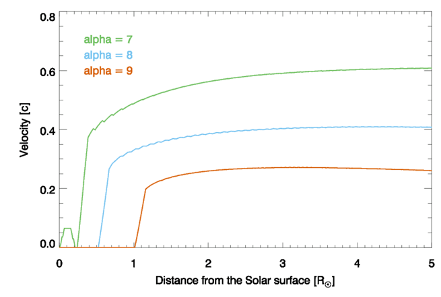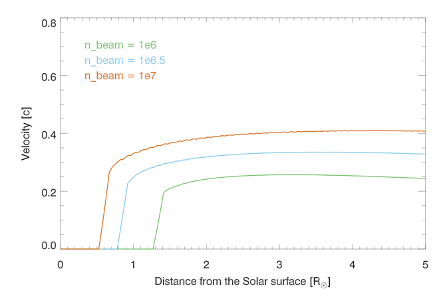Solar accelerated electron beams interact with the background plasma of the solar wind to locally generate Langmuir waves and subsequently produce radio emission (Ginzburg and Zhelezniakov 1958).
Numerous observations at different distances from the Sun by spacecrafts like Solar Orbiter (0.5AU) and ACE (1AU) show different energy ranges of electrons interacting with the plasma to produce Langmuir oscillations. At 0.5AU, non-thermal electrons in the deca-keV range arrive co-temporal to the Langmuir oscillations (Gomez-Herrero et al, 2021). At 1AU, there are no associated plasma waves observed the same energy electrons propagate scatter free, and (Dröge and Kartavykh, 2009). Langmuir waves close to the Sun have been observed with higher energy electrons and Langmuir waves farther away from the Sun arrive with lower energy electrons. This shows that there is a limit in the energy range of electrons for resonant wave-particle interactions, highly dependent on distance, that needs to be investigated further.
Numerical studies of electron beam dynamics as they travel through the solar plasma show that the kinetic properties of these beams depend highly on the initial electron beam parameters like the electron density and the electron energy distribution (Li and Cairns, 2013a, Reid and Kontar 2018).
Maximum electron velocity growing Langmuir waves, X

Figure 1. Maximum electron velocity [X] responsible for Langmuir wave growth from the Sun’s surface to 50 solar radii. X peaks at solar radii at 0.38c. In red is a fit showing X decreases as r-0.5 over the maximum velocity data in blue. (from Lorfing and Reid, 2023)
We simulate the injection of an electron beam in the solar corona and the subsequent propagation out into interplanetary space. Wave-particle interactions are simulated using a quasilinear approach to kinetic theory, probing which electron velocities grow the most Langmuir waves at different distances from the Sun. The accelerated electron beam is injected in the solar corona at 0.014 solar radii. We calculate the maximum electron velocity growing Langmuir waves X at each point in distance from the injection site (0.014 solar radii) out to 50 solar radii (Figure 1). This is done by identifying the highest velocity where df/dv > 0 in the electron distribution function at each point in time. X initially increases to 0.38c at 5 solar radii and then decrease roughly as r-0.5 to 0.17c at 50 solar radii. At the same time, the amount of Langmuir waves grown above thermal level by the beam decreases from 6×104 at 13 solar radii to 8×103 at 33 solar radii.
Simulation work of beam-plasma interactions has shown that the velocity dependency of the electron distribution function follows a negative power law (Reid and Kontar 2018).
Velocity spectral index a and initial beam density nbeam


Figure 2. Maximum electron velocity growing Langmuir waves X for different values of a (top) and nbeam (bottom) between 0 and 5 solar radii. (from Lorfing and Reid, 2023)
We vary two initial beam parameters, the initial beam density nbeam and the velocity spectral index a to analyse their effect on the energy range of electrons resonantly interacting with the plasma of the inner heliosphere. The amount of Langmuir waves being produced at each distance is dependent on our choice of initial beam parameters that themselves control the initial beam density U. And increase in U makes the higher energy electrons more unstable to Langmuir wave growth, resulting in more Langmuir waves being produced. U depends on the electron density, and decreases as a function of distance. We observe agreeing results with higher values of a (more low energy electrons than high energy ones) leading to a lower X, and vice versa, but an overall decrease in X with distance (Figure 2, left). When we vary the initial beam density nbeam, a higher initial beam density is synonymous with more electrons at all velocities being injected. This results in a higher X for a higher nbeam and vice versa (Figure 2, right).
Conclusions
We find that the maximum electron velocity X growing Langmuir waves increases and peaks at 0.38c at 5 solar radii, and subsequently decreases as r-0.5 to 0.17c at 50 solar radii for a beam with nbeam = 107 cm-3 and spectral index a = 8. Modifying the initial beam parameters nbeam and a affects the initial beam density and in consequence affect X. We also find that at 13 solar radii, high energy electrons (60 keV) propagate scatter free, whilst low energy (10 keV) electron arrive earlier than expected with the electron distribution function experiencing diffusion in time, for the same nbeam-a pair. The associated simulated type III solar radio burst provides us with the velocity range of electron velocities of its parent electron beam that can interact resonantly with the background plasma of the inner heliosphere. We aim to test these simulations against readily available in-situ data from Solar Orbiter and Parker Solar Probe.
Based on a recent paper by C. Y. Lorfing and H. A. S. Reid, 2023, Sol. Phys., DOI: https://doi.org/10.1007/s11207-023-02145-2
References
Dröge, W. and Kartavykh, Y. Y.: 2009, ApJ, 693, 69
Ginzburg, V. L. and Zhelezniakov, V. V.: 1958, Sov. Ast. Vol. 2
Li, B.and Cairns, I. H.: 2013, JGR, 118, 4748-4759
Reid, H. A. S. and Kontar, E. P.: 2013, Sol. Phys., 285, 217-232
Reid, H. A. S. and Kontar, E. P.: 2018, ApJ, 867, 158
